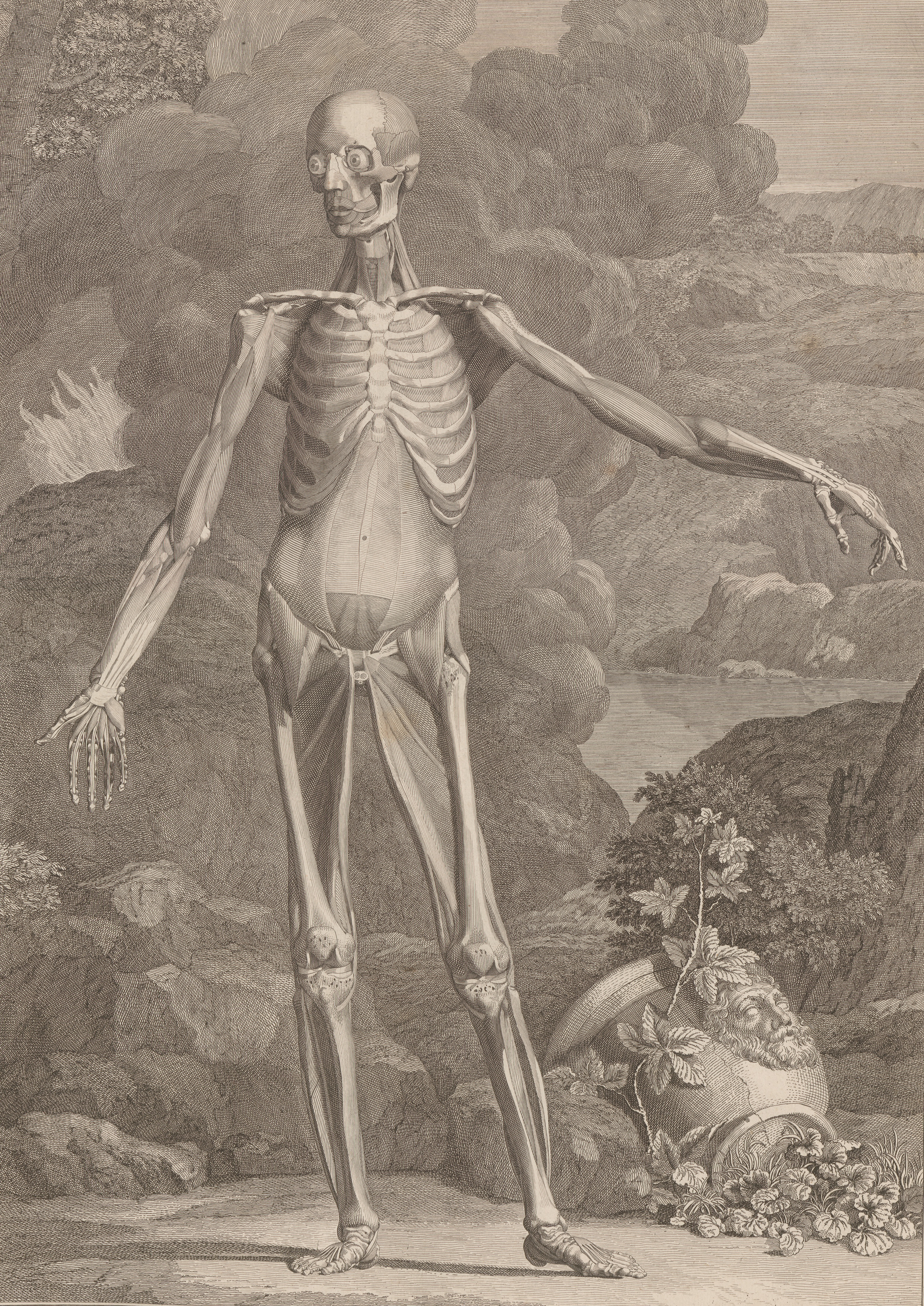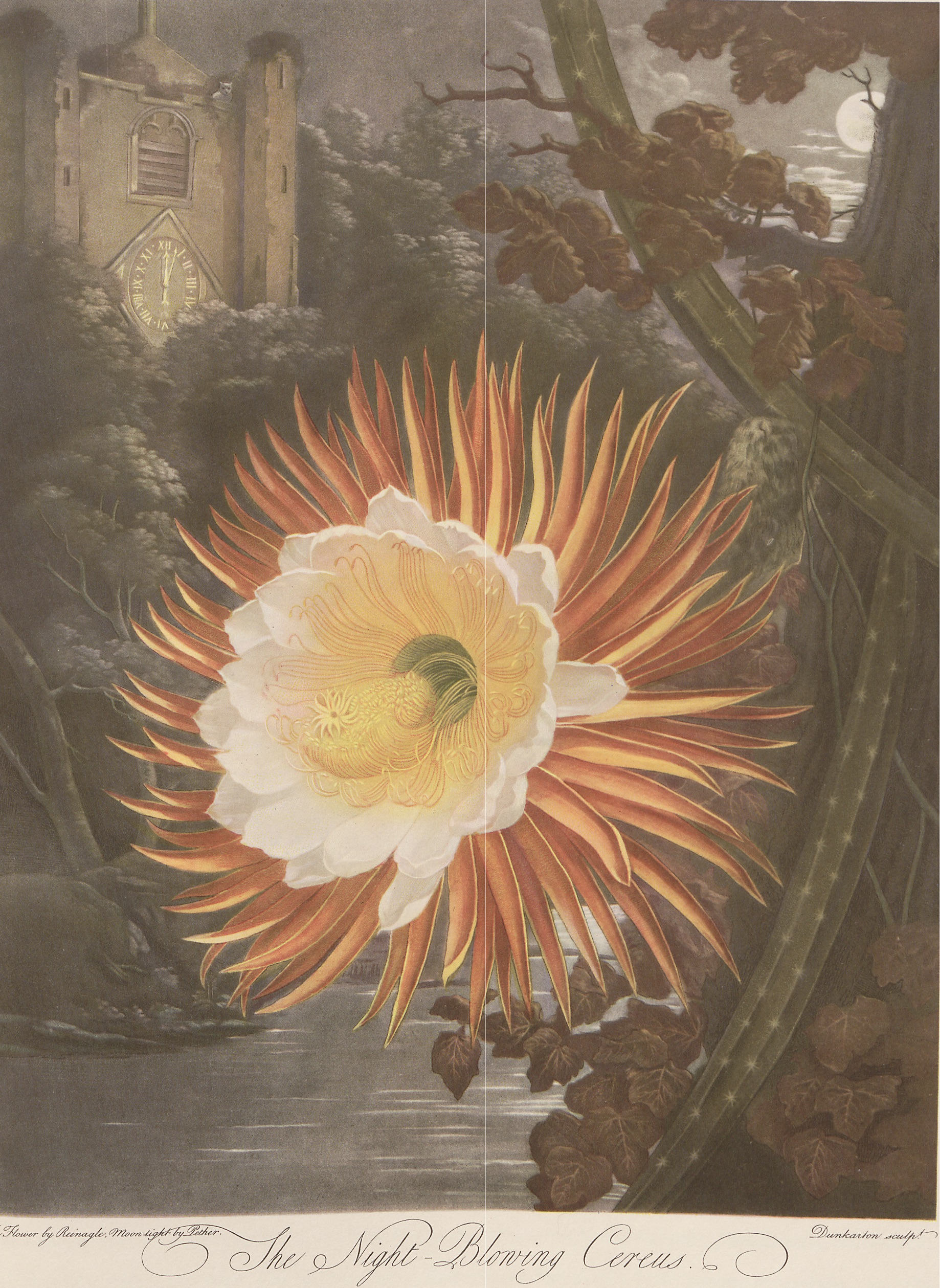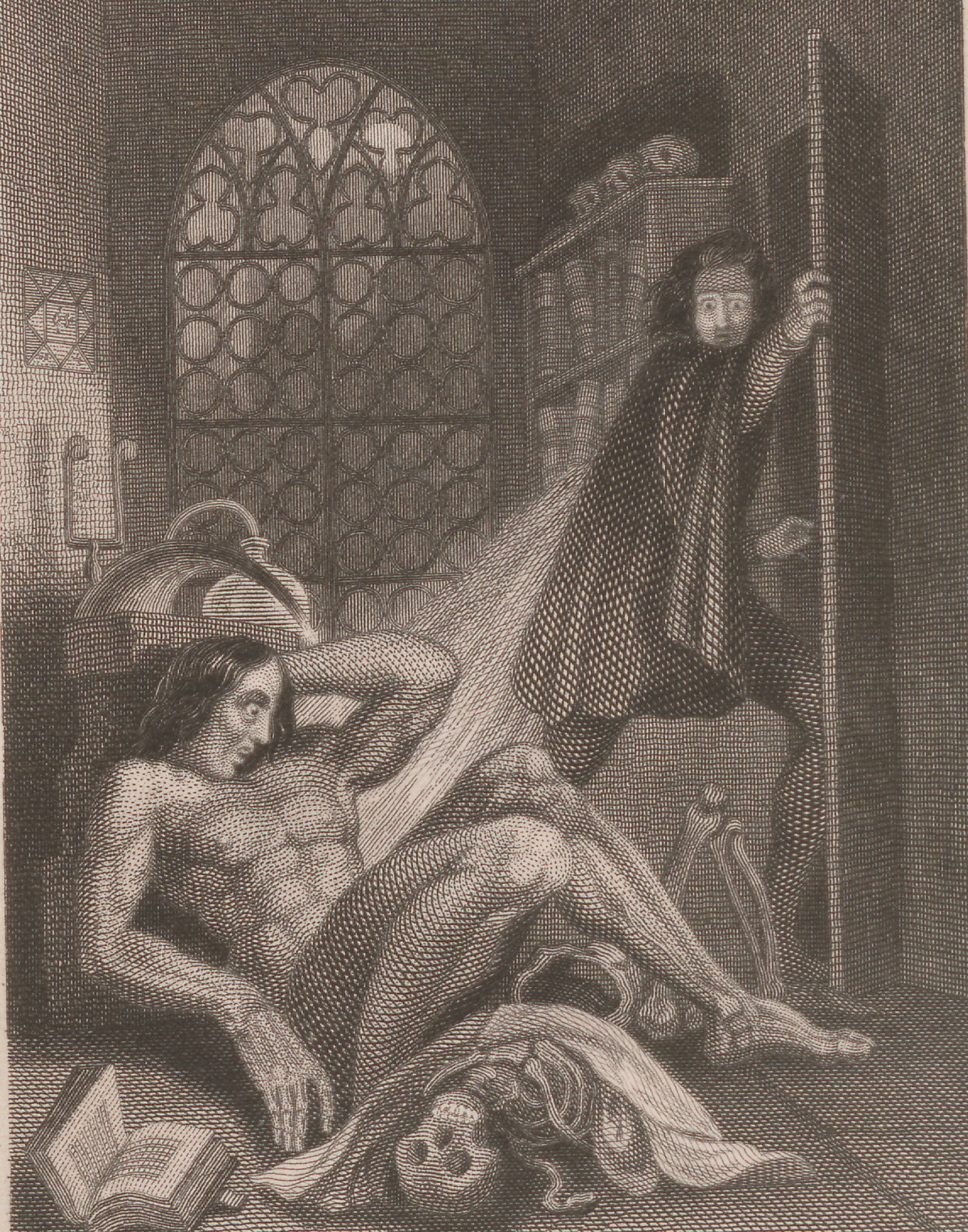Dark imaginings: gothic tales of wonder
In 18th century Europe a revolutionary shift in literary and artistic expression took place that became known as ‘the Gothic’. Nightmarish images of barbarity, oppression and the supernatural were abstracted from an earlier medieval (or ‘Gothic’) age and fused with a Romantic focus on imagination and emotion, resulting in works of frightening and thrilling originality. Leading exponents of the gothic set their creative works in dark and claustrophobic spaces or wild, threatening landscapes and infused them with melancholy, gloom and fear.
DARK IMAGININGS: GOTHIC TALES OF WONDER, an exhibition in the Noel Shaw Gallery, Baillieu Library, explored the expression of the Gothic from the mid-18th century to the end of the 19th century, primarily as represented in the University’s Special Collections. It marked a number of important gothic anniversaries, including the bicentenary of the first publication of Mary Shelley’s Frankenstein and the 200th birthday of Emily Brontë, author of Wuthering Heights.
-

Bernhard Siegfried Albinus
Tables of the skeleton and muscles of the human body
London: Printed by H. Woodfall for John and Paul Knapton
1749
Rare Books (Brownless Medical Collection)
University of Melbourne Library -

Robert Thornton
Thornton's Temple of Flora: with plates faithfully reproduced from the original engravings….
London: Collins
1951
Rare Books
University of Melbourne Library. -

Mary Wollstonecraft Shelley
Frankenstein, or, The modern Prometheus
London: Henry Colburn and Richard Bentley
1831
Rare Books
University of Melbourne Library -

Lieutenant-Colonel Hort
The embroidered banner: and other marvels with eight coloured steel etchings
by Alfred Ashley
London: John & Daniel A. Darling
1850
Rare Books
University of Melbourne Library. -

Robert Burns (author), John Faed (artist), Tam O'Shanter. [Edinburgh]: For the members of the Royal association for the promotion of the fine arts in Scotland, 1855. Rare Books, University of Melbourne. -

: Jean Aldini, Essai theorique .. sur le galvanisme. Paris: De l'imprimerie de Fournier fils, 1804. Rare Books, University of Melbourne
1 March 2018 – 31 July 2018
Noel Shaw Gallery,
Baillieu Library
The exhibition is arranged thematically. One space—which emulates a drawing room—celebrates the act of reading in the context of gothic literature and features early editions of celebrated gothic novels. Another space explores the so-called “Graveyard poets” and “resurrectionists” (or body snatchers) and another the preoccupations of the anatomists and followers of Luigi Galvani, whose attempts at re-animating the dead were of direct influence on Mary Shelley. Gothic places and psychological states—illuminated by the artistic works of Henry Fuseli, Salvator Rosa, G.B. Piranesi, Francisco Goya, John Martin, Charles Méryon and others—are the focus of the rest of the gallery.

The exhibition also embraces both trick photography and magic lantern slides, and their projectors (on loan from the Melbourne Museum), as providing a means to realise ghosts and other paranormal happenings such as levitation in more-or-less convincing ways.
Dark Imaginings extends beyond the gallery space. Academics involved in studying the gothic, and their students, have contributed in their areas of expertise (click on the Gothic Research tab above). Students at the University of Melbourne are encouraged to enter a Gothic micro-story competition, where prizes and publication in Farrago await the winning stories of 300 words or less. Finally, a vibrant program of public events is currently underway.
All exhibition public programs are FREE but bookings are required. Further information about the event can be found on each booking page.
Thursday 15 March, 12 – 1pm
Noel Shaw Gallery, Level 1, Baillieu Library
Curator’s Floor Talk
Dr Jen Hill, Exhibition Curator
Thursday 19 April, 12 – 2pm
The Architecture of Horror: Gothic Writing Workshop
Leigh Scott Room, Level 1, Baillieu Library
Dmetri Kakmi, Author
Thursday 17 May, 12 – 1pm
Dark Tourism: Ghosts and the Gothic Theatre of Victoria’s Heritage Sites
Leigh Scott Room, Level 1, Baillieu Library
Professor Mary Luckhurst, University of Melbourne
Thursday 14 June, 12 – 1pm
In Conversation: Speculative Fiction
Leigh Scott Room, Level 1, Baillieu Library
Hosted by Louise Swinn
Thursday 28 June, 12 – 1pm
Transnational Draculas
Leigh Scott Room, Level 1, Baillieu Library
Professor Ken Gelder, University of Melbourne
Poster Front
Poster Reverse
Original contributions by scholars of the gothic, postgraduate students and Special Collections curators, written to complement the 2018 Baillieu Library exhibition.
-
Shakespeare and the Gothic
Horace Walpole’s The Castle of Otranto (1764) is widely regarded as the first gothic novel in English. Curiously, as Anne Williams and Christy Desmet have observed, the origins of gothic literature roughly coincided with the elevation of Shakespeare to the status of Britain’s national poet in the late eighteenth century, such that ‘Shakespeare’ and the gothic were ‘born together’.
-
Manuscript Ghosts: Reader and Writer in Romantic Gothic Fiction
In Northanger Abbey, Jane Austen’s affectionate parody of late 18th-century gothic novels, the unlikely heroine, Catherine, discovers what she believes is a manuscript in an ‘old-fashioned black cabinet.’ 1) After struggling with the locks and searching through a series of empty drawers, the reader’s suspense and Catherine’s curiosity are rewarded by ‘a roll of paper…[on which] half a glance sufficed to ascertain written characters.’2)
-
Graveyard Poetry
Graveyard poetry is, first and foremost, a devotional mode of poetry. Popular in the early to mid-eighteenth century—that is, in the decades immediately preceding Horace Walpole’s seminal Gothic novel, The Castle of Otranto (1764)—it is a mournful brand of poetics designed to facilitate Christian meditation on dying, death and the afterlife by way of the affective imagination.
-
Ghosts of the Past: Contemporary Australian Gothic Theatre
The sublime horrors and lethal dangers of the Australian landscape are the subject of both true story and myth and were circulated by the first waves of white European settlers who arrived from the late eighteenth century onwards.
-
Mezzotints and their Dark Affair with Science and Literature
Mezzotint might just be the perfect medium for gothic imagery as the artist begins with a completely dark, almost terrifying, surface and gives their image life by drawing with light. Renowned English examples of this luminous art form hang in the exhibition Dark imaginings.
-
Dark botanics: gothic forms in Thornton's Temple of flora
The dark tendrils of the gothic permeated the eighteenth-century domain, unveiling its nightmarish preoccupations in disparate ways. In the worlds of science and nature, a gothic impulse infected the upper-class taste for plant exotica, and disquieted a public who were introduced to strange foreign species via the printed page.
-
My Twenty-One Best Gothic Novels: A Book Collectors perspective
This is a list of my twenty-one most desirable examples of Gothic Literature from a book collector's perspective. In this article, I will briefly discuss elements of the publication history of the first six of the twenty-one works that I have chosen.
-
Bram Stoker's Dracula, the King Vampire
There are few names from literature and popular culture that are as well known as that of Dracula. Dracula stars in more than two hundred films, appears in numerous television shows, has taken to the stage not only in drama but also musicals, ballet, and opera, features in video games and comics, and, of course, appears in many vampire fictions in addition to the original novel that bears his name.
-
Gothic Veils: A Critique of the Sentimental Feminine Ideal in Ann Radcliffe's The Mysteries of Udolpho
Gothic novels descended from the sentimental tradition. In fact, female Gothic fiction could be described as a sentimental novel with a twist, the twist of course being intimations of the supernatural. The Gothic is often studied through an interpretation of its motifs. One of the most prominent motifs, the image of the veil, was made popular by Ann Radcliffe’s The Mysteries of Udolpho (1794) and has its roots in the sentimental tradition.
-
Feminism and the Gothic: A Brief History
One of the most interesting things about the rise of gothic fiction in the late eighteenth century is that it coincided with the emergence of what we now recognise as modern-day feminism. Although Horace Walpole’s (1717–1797) The Castle of Otranto (1764) is widely considered to have been the first gothic novel, it was a female author, Ann Radcliffe (1764–1823) who popularised the form in the final decades of the eighteenth century.
-
Gothic Ghosts: Representation of Feminine Passion in Ann Radcliffe's The Mysteries of Udolpho
Ann Radcliffe employs spectres to explore the difficulties inherent to the representation of feminine passion and identity in a male dominated culture. This is particularly true of The Mysteries of Udolpho (1794) which has a plot that revolves around understanding the disjointed stories of two primary ghosts: Signora Laurentini, and the Marchioness de Villeroi.
-
Gothic Realities: Tabloid Coverage of the Macabre in the Nineteenth Century
There is a common misconception that the nineteenth century ushered in a time of restraint and manners, when polite society shuddered at the thought of unbridled passions and moral decline. But the reality was that popular interest in sensationalist stories of violent crimes, dramatic natural disasters, and bloody accidents reached an all-time high in the Victorian era.
-
Galvanising George Foster, 1803
Until 1832 the corpses of every person hanged for murder in London were carted to the College of Surgeons to be dissected. These were the only bodies legally available to medical men, under An Act for better preventing the horrid Crime of Murder (1752), which made dissecting or gibbeting the corpse a secondary punishment for this crime alone. The dissections carried out at the College were public events, theatrically performed. Then the bodies were experimented upon, or turned into gifts for well-connected surgeons elsewhere.
-
The Satanic Alps
During the Romantic period in the early nineteenth century, Switzerland and its Alps were most often portrayed as a kind of utopian alpine idyll, stocked with idealised democratic peasant republicans in harmony with nature. This was thanks firstly to the Swiss Confederation’s long history of independent republicanism and direct democracy, which appealed to both radical and conservative writers alike.
-
The Vampire in Paranormal Romance and Urban Fantasy
In the quote below, Bella Swan, heroine of Stephenie Meyer's controversial vampire romance, the Twilight Saga, seems to summarise the basic premise of the paranormal romance genre. The story has practically become cliché: girl meets boy, boy and girl fall in love, but boy sort of wants to eat girl, yada yada yada …. And, of course, there's sometimes a werewolf in there - or a wereleopard, or a fairy lord, or a demon, or a zombie, or all of the above. It's important to keep things interesting, after all.
-
Gothic bluebooks: The popular thirst for fear and dread
Visitors to the Dark Imaginings exhibition may find themselves drawn to two hand-sized books, immediately distinguishable by their melodramatic titles, and exaggerated illustrations in splashes of bright colour.
-
Gothic Doubles: Feminine Identity Formation in Mrs. Isaac's Ariel, or The Invisible Monitor (1801)
Ann Radcliffe popularized the technique of exploring the heroine's internal, psychological states of mind through the creation of an external double. She did this through the missing mother in The Romance of the Forest (1791) and The Italian (1797), and the mysterious spectres that haunt the text in A Sicilian Romance (1790) and The Mysteries of Udolpho (1794).
The Gothic Micro-Story Competition Winners
1ST PRIZE Victor Hu: The Fish-men
2ND PRIZE Lily Laycock: Wisteria
3RD PRIZE Andreas Katsineris-Paine: The Monster which Haunted Belle Tarney
Thank you to everyone who entered and congratulations to the winners.
All current University of Melbourne students are warmly invited to write a gothic-themed micro-story and enter a competition associated with the exhibition Dark imaginings: gothic tales of wonder currently in the Baillieu Library using the form below.
The challenge is that you have just 300 words (or less) to tell your story (excluding title). While the exhibition focuses on the gothic from c 1750 to 1900, you can interpret the word “gothic” freely and choose any setting you wish

Professor Peter Otto, an expert on gothic literature, and Dr Elizabeth MacFarlane, Head of the Creative Writing program (both from the University of Melbourne) have generously agreed to judge the shortlisted entries. There will be prizes for all the winning stories and they will also be featured in Farrago magazine.